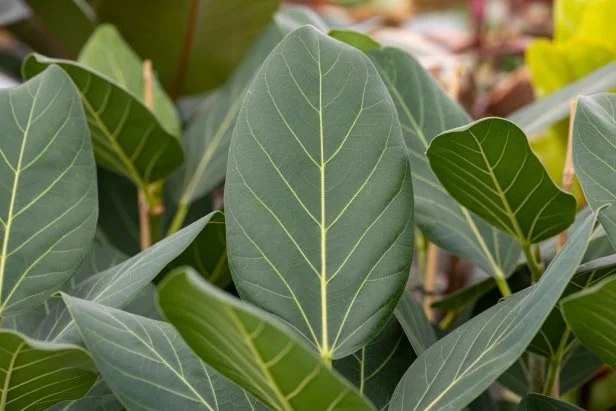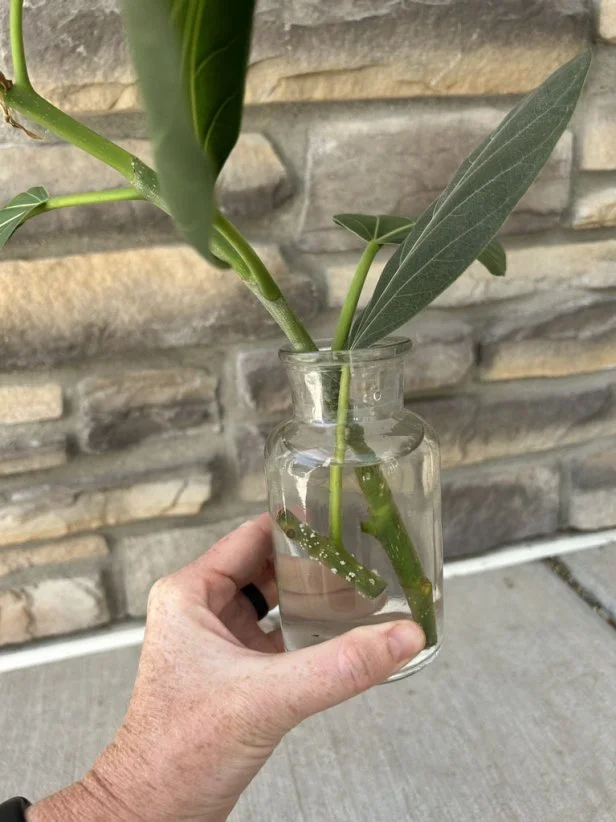Discover the Beauty of Ficus 'Audrey'
Celebrate gorgeous greenery by adding a trendy Ficus ‘Audrey’ to your houseplant collection. Learn how to care for this no-fuss fig.

Shutterstock/Fabrizio Guarisco
Ficus ‘Audrey’ is a variety of Ficus benghalensis, also known as the Bengal fig or banyan tree. ‘Audrey’ is a smaller version of the banyan tree, growing 5 to 6 feet tall indoors.
Give your home a touch of grace and elegance with 'Audrey' ficus. This popular plant combines great looks with an easy-grows-it personality. It's the perfect choice for new plant parents and more experienced green thumbs alike.
'Audrey' ficus is a variety of Ficus benghalensis, also known as banyan tree, beghalensis ficus or fig, Bengal fig and Indian banyan. Ficus benghalensis is the national tree of India, where it grows up to 100 feet tall — and even wider, thanks to aerial roots that drop from branches and sink into soil. In South Florida, you can find amazing benghalensis ficus trees in places like Boca Grande, Selby Botanical Gardens and the Edison and Ford Winter Estate.
Indoors, expect your 'Audrey' ficus to grow 5 to 6 feet tall, making it a terrific tree choice for any home. In an ideal environment, Ficus 'Audrey' can survive as an interior plant for 20 or more years.
Botanical name: Ficus beghalensis 'Audrey'
Common Name: 'Audrey' ficus or Ficus 'Audrey'
Special features: Indoor tree with emerald green leaves
Plant Type: Houseplant
Size: 5 to 10 feet tall indoors and up to 3 feet wide
USDA Hardiness Zones: Can be grown outdoors in Zones 10 to 11 but is considered invasive in many areas. Do not plant outside without checking its status locally.
Ficus 'Audrey' Care
Pretty Ficus 'Audrey' is related to other admired fig houseplants, including fiddle leaf fig (Ficus lyrata), weeping fig (Ficus benjamina) and rubber tree (Ficus elastica). Caring for Ficus 'Audrey' falls somewhere between fiddle leaf fig (difficult) and rubber tree (very simple). Learn what you need to know to succeed with 'Audrey' ficus.
Light
Ficus 'Audrey' prefers bright, indirect light. Place it near an east-facing window, if possible. A south- or west-facing window will work, too, but don't put the plant directly by the window where strong sunlight may scorch leaves. Ficus 'Audrey' isn't a low-light plant like snake plant. If you plan to use it in a darker room or corner, add a grow light to keep it strong and healthy.
Water
The rule of thumb for watering Ficus 'Audrey' is to water when the top 2 to 3 inches of soil are dry to the touch. This ficus isn't as picky about watering as a fiddle leaf fig and won't respond with dramatic leaf loss when you get it slightly wrong.
Ficus 'Audrey' prefers soil that's evenly moist. Don't let it dry out completely, but don't overwater and make soil soggy. When Ficus 'Audrey' is too dry for too long, it will drop leaves and growth will be stunted. Don't water it on a schedule (once a week), but instead touch soil and learn what the plant needs that way.
Humidity
In the wild, Ficus benghalensis grows in tropical rainforests, a place with high humidity. The average home environment is much drier than a rainforest, but should be fine for your 'Audrey' ficus. If leaf edges become crispy or brown, low humidity may be the problem. To raise humidity, group Ficus 'Audrey' with other houseplants, run a humidifier or set the plant on a pebble tray filled halfway with water.

Shutterstock/Megan Czarnocki
'Audrey' Ficus is an indoor tree that’s easy to grow and has simpler care requirements than other well-known ficus varieties, such as fiddle leaf fig or weeping fig.
Temperature
Ficus 'Audrey' thrives in typical indoor conditions. Cool temps are a problem for this tropical rainforest native. Keep air temperatures from 65 degrees to 85 degrees, and avoid letting hot or cold drafts blast 'Audrey' ficus. Place it away from heating and cooling vents, as well as outside doors, especially in northern regions in winter.
Fertilizer
Like many houseplants, Ficus 'Audrey' grows most actively during spring and summer. In this timeframe, feed it once a month using a liquid houseplant food. Another option is to add slow-release houseplant fertilizer (a granular type) to soil in spring. In fall and winter, plant growth slows, so there's no need to fertilize plants.
Buy Fertilizer
Pruning 'Audrey' Ficus
Because Ficus 'Audrey' has the potential to grow quite tall, you'll need to prune it on occasion. The best time for pruning 'Audrey' ficus is in spring or summer because that's when the plant grows the most. Reasons for pruning include controlling plant size, adjusting plant appearance or encouraging branching.
Remove any wayward or really long, leggy stems that make the plant off-balance. Make cuts back to the main stem in this instance to promote more branching from the base of the plant. Or you might want to prune 'Audrey' ficus to a tree-like shape with a bare trunk that branches at the top.
Like all ficus, 'Audrey' contains a latex-like sap that's sticky, can stain and might irritate skin. It's a good idea to wear gloves when pruning. Cover surrounding surfaces to prevent ficus latex from removing the finish on furniture or flooring.
One other key to keeping your Ficus 'Audrey' in tip-top shape is rotating the plant each time you water. Give it a quarter turn to encourage even growth on all sides of the plant.
Repotting 'Audrey' Ficus
If you love repotting houseplants, Ficus 'Audrey' isn't the right plant for you. This emerald-leaved beauty doesn't need regular repotting, but actually likes being a little root bound in its pot. When you notice roots emerging from the drainage holes of your pots (every two or three years), that's a sign it's time to repot.
If you want your Ficus 'Audrey' to keep growing bigger, repot your plant into a pot size that's 2 inches larger in diameter than the one your plant is presently in. If you're happy with the size of your Ficus 'Audrey', remove some of the larger roots and repot it in the same pot. When root pruning, don't remove more than one-third of the entire root system.
To avoid overwatering Ficus 'Audrey', use a well-draining plant mix. Achieve this by adding one part perlite to two or three parts cactus mix. Or simply add orchid bark and/or perlite to a quality plant mix for indoor plants.

Shutterstock/Megan Czarnocki
One of the most popular — and easiest — ways to propagate Ficus 'Audrey' is by taking cuttings and placing them in water until roots form.
Propagating 'Audrey' Ficus
Rooting stem cuttings is the easiest way to propagate Ficus 'Audrey'. When taking cuttings, select a branch with a green stem that has several leaves. New growth is always a good choice. Place the cutting in water in a bright, warm spot. It will take three or four weeks for roots to appear. Change the water at least once a week.
If you have a root zone heating mat, place your container of water with the cuttings on that, and roots might form more quickly. When roots are a couple inches long, pot your cuttings.
Also, remember to wear gloves to protect your hands from sap during this process.
Troubleshooting 'Audrey' Ficus
- Yellow leaves — Yellow leaves at the bottom of the plant are a sign of overwatering. Yellow leaves all over the tree combined with dry soil are a clue that you're under-watering. If the water situation is under control, yellow leaves might be a cry for fertilizer.
- Brown, crispy leaves — Dried up leaves reveal an under-watered plant. Crispy leaf edges may hint that 'Audrey' needs higher humidity. High fluoride or salts (softened water) can also cause leaf edges to brown. Trying using distilled water for irrigation.
- Drooping leaves — Wilting is usually caused by one of three issues: The soil has dried out completely; the soil is super soggy and root rot disease has set in; or you have recently transplanted 'Audrey' and she's in shock (and will recover). If the problem is root rot, soil will have a sewer smell. You'll need to remove the plant from the pot and replace the soil with fresh potting mix.
- Pests — Mealybugs, spider mites and scale are common pests on 'Audrey' ficus. Watch for clues of their presence: sticky residue on leaves or pot rims (all three pests), webbing between leaves and stems (spider mites) or cottony masses under leaves (mealybugs). Treat Ficus 'Audrey' pests using products labelled for use on houseplants. Neem oil is a good choice for many indoor plant pests.
FAQs for Ficus 'Audrey'
Does Ficus 'Audrey' purify air?
'Audrey' ficus is an air-purifying houseplant. It's a good choice for spaces in your home where you spend the most time.
Is Ficus 'Audrey' toxic?
If eaten, the parts of 'Audrey' ficus can cause stomach upset and vomiting — for people or pets. The sap irritates some people's skin.
Which is harder to care for: Ficus 'Audrey' or fiddle leaf fig?
'Audrey' ficus isn't as much of a diva as fiddle leaf fig (Ficus lyrata). It doesn't need as much light, and it's less sensitive to watering issues. While 'Audrey' isn't a fan of strong temperature changes, it's not as touchy as a fiddle leaf fig in this area, either.













































